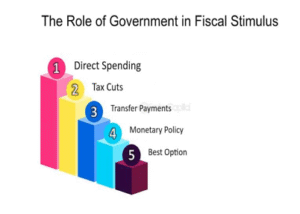
What is Fiscal Stimulus?
-
A set of government policies designed to revive a sluggish economy.
-
Central bank measures:
-
Increase money supply
-
Reduce interest rates to encourage spending
-
-
Government actions:
-
Increase public spending
-
Lower tax rates to put more money in consumers’ hands
-
-
Example:
-
During COVID-19, the central government announced a fiscal stimulus package worth ₹20 lakh crore.
-
Features of Fiscal Stimulus
-
Emerged as a key tool during global financial crises and recessions.
-
Can lead to higher deficits and debt levels, creating long-term challenges.
-
May divert economies away from fiscal consolidation and worsen fiscal deficit.
-
If used mainly for boosting consumption (not asset creation), it can trigger inflation.
Need for Fiscal Stimulus
-
To boost economic demand during:
-
Unemployment
-
Income shrinkage
-
Low consumer confidence
-
-
Helps to:
-
Revive business confidence
-
Restart stalled projects
-
Create jobs
-
Trigger a cycle of demand and growth
-
-
Particularly important during pandemic-induced job losses and global economic slowdown.
-
Supports wealth creation, which drives long-term economic growth.
Impacts of Fiscal Stimulus Framework
-
Causes a sudden rise in liquidity but may also bring risks like bankruptcies and organisational losses.
-
Can create a liquidity trap where interest rates fall, yet people prefer holding cash.
-
May push inflation upwards.
-
Government spending on health, food, and income support for vulnerable groups can strain finances.
-
Leads to higher public debt, weakens credit ratings, and worsens public finances.
Key Terms Explained
-
Fiscal Consolidation – Reducing government deficit and debt.
-
Fiscal Deficit – Govt. spending > revenue (excluding borrowings).
-
Liquidity Trap – Low interest rates but people still hoard cash.
-
Virtuous Cycle – More spending → more jobs → more income → more spending.
-
Gross Public Debt – Total borrowings of govt. (domestic + foreign).
-
Credit Rating – Score of a country’s repayment ability by global agencies.
-
Organisational Capital – Knowledge and systems that keep firms running smoothly.
राजकोषीय प्रोत्साहन:
राजकोषीय प्रोत्साहन (Fiscal Stimulus) क्या है?
-
सुस्त अर्थव्यवस्था को पुनर्जीवित करने के लिए बनाई गई सरकारी नीतियों का एक सेट।
-
केंद्रीय बैंक के उपाय:
-
मुद्रा आपूर्ति बढ़ाना
-
ब्याज दरें घटाकर खर्च को प्रोत्साहित करना
-
-
सरकार के कदम:
-
सार्वजनिक खर्च बढ़ाना
-
उपभोक्ताओं के हाथों में अधिक पैसा देने के लिए कर दरें कम करना
-
-
उदाहरण:
-
कोविड-19 के दौरान केंद्र सरकार ने ₹20 लाख करोड़ का राजकोषीय प्रोत्साहन पैकेज घोषित किया।
-
राजकोषीय प्रोत्साहन की विशेषताएँ
-
वैश्विक वित्तीय संकटों और मंदी के दौरान एक प्रमुख उपकरण के रूप में उभरा।
-
उच्च घाटे और ऋण स्तर का कारण बन सकता है, जिससे दीर्घकालिक चुनौतियाँ पैदा होती हैं।
-
अर्थव्यवस्था को राजकोषीय समेकन (Fiscal Consolidation) से दूर कर सकता है और राजकोषीय घाटा बढ़ा सकता है।
-
यदि इसका उपयोग मुख्य रूप से खपत बढ़ाने (न कि परिसंपत्ति निर्माण) के लिए होता है, तो यह महँगाई को बढ़ा सकता है।
राजकोषीय प्रोत्साहन की आवश्यकता
-
आर्थिक मांग को बढ़ाने के लिए, विशेष रूप से:
-
बेरोज़गारी
-
आय में कमी
-
उपभोक्ता विश्वास की कमी
-
-
मदद करता है:
-
व्यापारिक विश्वास को पुनर्जीवित करना
-
रुकी हुई परियोजनाओं को दोबारा शुरू करना
-
रोजगार सृजित करना
-
मांग और विकास का चक्र शुरू करना
-
-
महामारी से प्रेरित नौकरी हानि और वैश्विक आर्थिक मंदी के दौरान विशेष रूप से महत्वपूर्ण।
-
धन सृजन का समर्थन करता है, जो दीर्घकालिक आर्थिक विकास को आगे बढ़ाता है।
राजकोषीय प्रोत्साहन ढाँचे के प्रभाव
-
तरलता (Liquidity) में अचानक वृद्धि का कारण बनता है, लेकिन साथ ही दिवालियापन और संगठनात्मक नुकसान जैसे जोखिम ला सकता है।
-
Liquidity Trap पैदा कर सकता है, जहाँ ब्याज दरें घट जाती हैं लेकिन लोग नकद रखना पसंद करते हैं।
-
महँगाई को ऊपर की ओर धकेल सकता है।
-
स्वास्थ्य, खाद्य और कमजोर वर्गों के लिए आय समर्थन पर सरकारी खर्च वित्तीय बोझ डाल सकता है।
-
उच्च सार्वजनिक ऋण का कारण बनता है, क्रेडिट रेटिंग को कमजोर करता है और सार्वजनिक वित्त को बिगाड़ता है।
प्रमुख शब्दों की व्याख्या
-
Fiscal Consolidation – सरकार के घाटे और ऋण को कम करना।
-
Fiscal Deficit – सरकारी खर्च > राजस्व (उधारी को छोड़कर)।
-
Liquidity Trap – कम ब्याज दरें लेकिन लोग फिर भी नकद जमा करना पसंद करते हैं।
-
Virtuous Cycle – अधिक खर्च → अधिक नौकरियाँ → अधिक आय → अधिक खर्च।
-
Gross Public Debt – सरकार की कुल उधारी (घरेलू + विदेशी)।
-
Credit Rating – वैश्विक एजेंसियों द्वारा किसी देश की पुनर्भुगतान क्षमता का स्कोर।
-
Organisational Capital – वह ज्ञान और प्रणाली जो कंपनियों को सुचारु रूप से चलाती है।




